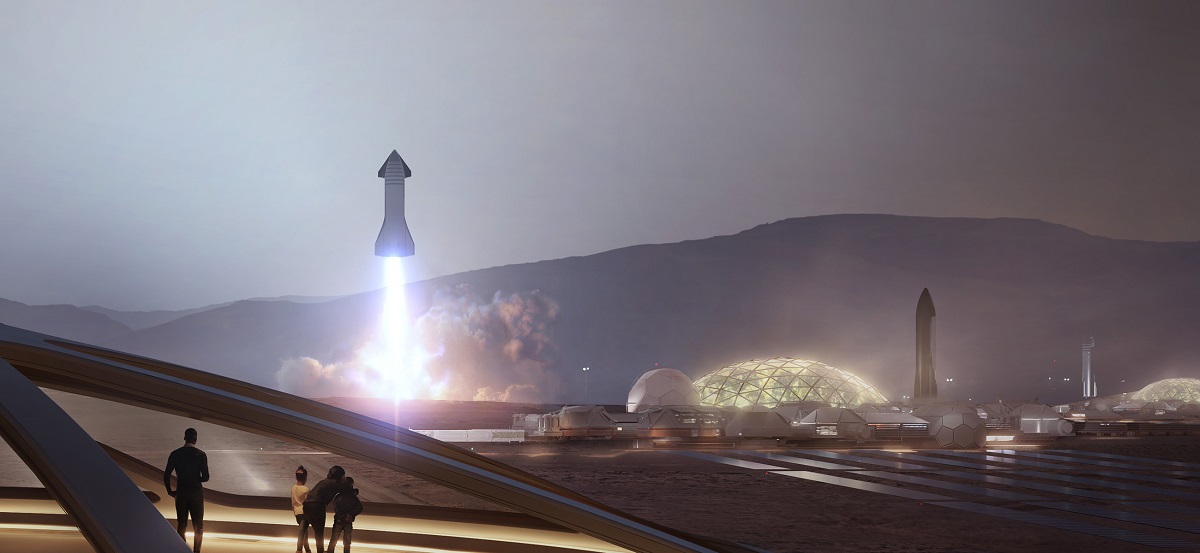With the advancement of technology, we are edging closer to a new era of space exploration. Neighboring Mars seems within reach like never before as NASA’s missions show, but our appetites are continuously increasing on that front. Companies, agencies, and individuals are already envisioning settlements and colonies on the Red Planet.
One of the most ambitious projects comes from an architectural think-tank named ABIBOO. They already have a fairly detailed plan about how the first self-sustaining cities on Mars should look like.
Nüwa – the underground city
Nüwa, as they call it, should be built inside a cliff, with a network of tunnels connecting the residential areas, the buffer zones, and all the other buildings. Building an underground city is logical on Mars as it offers protection against radiation, meteorites, and dust storms. At the places where the city reaches the cliffside, the residents will be able to enjoy in the so-called Green Domes. According to the draft, there are two types of these sunny halls: those that allow human presence and act as parks, and those that include experimental vegetation in an environment with a purely Martian atmosphere.

At the foot of the cliff, large pavilions have been located for social interaction in the Valley. These pavilions have been designed with translucent skin to offer views of the landscapes of Mars. These domes are protected from external radiation by large overflying canopies. The material from the cliff’s excavation is dumped on top of such roofs, protecting from radiation. At the same time, this strategy ensures recyclability even at a large-scale. In the Valley, there are also specific structures to house hospitals, schools and universities, sports and cultural activities, shopping areas, and train stations that communicate with the space shuttle.

The name of the city comes from Chinese mythology, or more specifically from the mother goddess Nüwa who was credited for creating humanity. The chosen place for the settlement is Tempe Mensa, where the people behind the project expect abundant water access. That would be one of the crucial things for sustaining a permanent human presence on Mars. The plan is to kickstart the development with capital investments and supplies from Earth, until the system becomes able to sustain its growth with local resources only. The people would be fed mostly by cultivated crops as well as microalgae. Some farms animals and fish could be brought from our planet, but their impact on the diet would probably be insignificant.
An expensive one-way ticket to Mars

Amusingly, the goal is for the city to have a population of around 250.000 people. But before you start packing your bags, have in mind that the one-way ticket will cost around 300.000 dollars. In the price a living place of ~25-35 m2/person is included, just as full access to common facilities, all life support services & food. However, there is a binding contract that will force the Martians to devote between 60% and 80% of their work time to tasks assigned by the city. A regular shuttle service is expected to operate between the two planets, with launch windows opening approximately every 26 months and lasting between one and three months.
What about Elon Musk and SpaceX?
The eccentric billionaire Elon Musk is also pretty confident that he can colonize and even terraform Mars. In the past few years, he keeps on providing some details about his plans. His company SpaceX is still testing and improving the Starship rockets, but according to him, the first crewed flights to Mars could happen as early as 2026. A self-sustaining city on the Red Planet could emerge around 2050.

Regarding food for the residents, Musk believes that he can rely on hydroponics – a method of growing plants, usually crops, without soil, by using mineral nutrient solutions in an aqueous solvent. In an interview for Popular Mechanics he added:
For having an outdoorsy, fun atmosphere, you’d probably want to have some faceted glass dome, with a park, so you can walk around without a suit. Eventually if you terraform the planet, then you can walk around without a suit. But for say, the next 100-plus years, you’ll have to have a giant pressurized glass dome.
In the past, there were some unsuccessful projects for sending humans to Mars, but this milestone seems inevitable and a question of time. Whenever it happens, let’s hope that we will be able to witness it.














